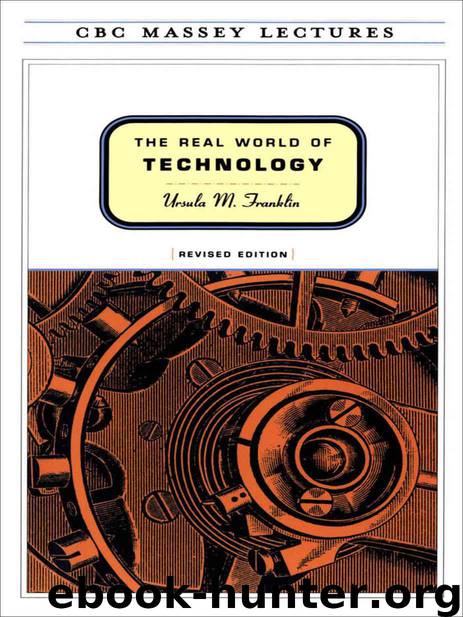The Real World of Technology (CBC Massey Lecture) by Franklin Ursula M

Author:Franklin, Ursula M. [Franklin, Ursula M.]
Language: eng
Format: epub, pdf
Tags: SOC000000
Publisher: House of Anansi Press
Published: 2011-09-03T10:00:00+00:00
The sewing machine will, after some time, effectively banish ragged and unclad humanity from every class. In all benevolent institutions, these machines are now in operation and do or may do 100 times more towards clothing the indigent and feeble than the united fingers of all the charitable and willing ladies collected through the civilized world could possibly perform.7
The authors of this prognostication evidently assumed that the introduction of the sewing machine would result in more sewing — and easier sewing — by those who had always sewn. They would do the work they had always done in an unchanged setting.
Reality turned out to be quite different. With the help of the new machines, sewing came to be done in a factory setting, in sweatshops that exploited the labour of women and particularly the labour of women immigrants. Sewing machines became, in fact, synonymous not with liberation but with exploitation. The sewing machines at home were used less, as machine-sewn household goods and garments began to be readily available on the mass market. These garments were produced by the prescriptive technologies that created a situation in which one seamstress only sewed up sleeves, another worker put them in, another made buttonholes, another pressed the shirts. A strictly prescriptive technology with the classic division of labour arose from the introduction of new, supposedly liberating “domestic” machines. In the subsequent evolution of the garment industry, much of the designing, cutting, and assembling began to be automated, often to the complete exclusion of workers.
The social history of the industrialization of clothing is similar to the current phase in the industrialization of eating. Food outlets put frozen or chemically prepared “unit meals” together like sleeves and collars for shirts — there are “Mc-Jobs” and no security of employment. Indeed, women sew less, cook less, and have to work hard outside the home to be able to buy clothing and food.
What turns the promised liberation into enslavement are not the products of technology per se — the car, the computer, or the sewing machine — but the structures and infrastructures that are put in place to facilitate the use of these products and to develop dependency on them. The funny thing is that in the course of this process of spreading technology, the ordinary things — a home-cooked meal, an individually made garment — become prized and special, while what had been prized and extraordinary — for instance, cloth or fruit from the Orient — appears now to be quite ordinary and routine.
To recap: many new technologies and their products have entered the public sphere in a cloud of hope, imagination, and anticipation. In many cases these hopes were to begin with fictional, rather than real; even in the best of circumstances they were vastly exaggerated. Discussion focused largely on individuals, whether users or workers, and promised an easier life with liberation from toil and drudgery. Discourse never seemed to focus on the effects of the use of the same device by a large number
Download
The Real World of Technology (CBC Massey Lecture) by Franklin Ursula M.pdf
This site does not store any files on its server. We only index and link to content provided by other sites. Please contact the content providers to delete copyright contents if any and email us, we'll remove relevant links or contents immediately.
Learning SQL by Alan Beaulieu(6239)
Weapons of Math Destruction by Cathy O'Neil(6220)
Digital Minimalism by Cal Newport;(5707)
iGen by Jean M. Twenge(5387)
Sapiens by Yuval Noah Harari(5325)
The Age of Surveillance Capitalism by Shoshana Zuboff(4252)
Elon Musk by Ashlee Vance(4088)
Thing Explainer by Randall Munroe(3911)
Apollo 8 by Jeffrey Kluger(3672)
Future Crimes by Marc Goodman(3566)
The Science Book (Big Ideas Simply Explained) by DK(3256)
Who Can You Trust? by Rachel Botsman(3112)
The Innovators: How a Group of Hackers, Geniuses, and Geeks Created the Digital Revolution by Walter Isaacson(3006)
I Live in the Future & Here's How It Works by Nick Bilton(2963)
Infinite Energy Technologies by Finley Eversole(2954)
Steve Jobs by Walter Isaacson(2863)
Dawn of the New Everything by Jaron Lanier(2751)
Chernobyl by Serhii Plokhy(2516)
Ben Franklin's Almanac by Candace Fleming(2495)
